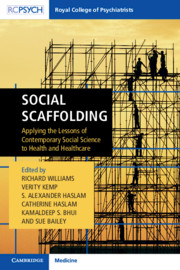Section 4 - Scaffolding
Published online by Cambridge University Press: 14 June 2019
Summary
The purpose of this chapter is to serve as a bridge between the chapters in the previous three sections and those in this fourth section. Thus far, we have sought to analyse the social bases of mental and physical wellbeing. Now, we turn to the question of how the fruits of these analyses can be applied in practice. That is, we have been reporting and interpreting the way the world impacts individual people for long enough; it is time to consider how we might change the world in order to improve our wellbeing.
- Type
- Chapter
- Information
- Social ScaffoldingApplying the Lessons of Contemporary Social Science to Health and Healthcare, pp. 213 - 328Publisher: Cambridge University PressPrint publication year: 2019

